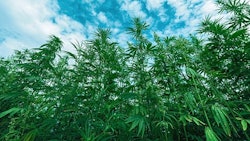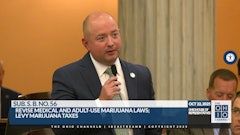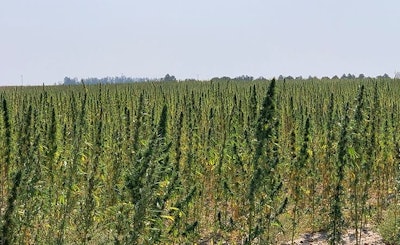
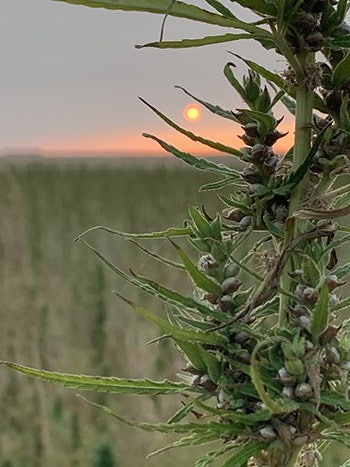 rabou farms wyoming
rabou farms wyomingRon Rabou knows his grain crops. He has been farming his family’s fifth-generation land in southeastern Wyoming, sowing and harvesting his fields to serve the growing plant protein market. Starting this past spring, he has added industrial hemp to his rotation at Rabou Farms.
In early 2019, Rabou helped shepherd the state’s hemp legislation to passage, paving the way for a new crop now made available to farmers in Wyoming. As he looked ahead to this current year, he began scouting genetics and finding ways to meet the growing plant protein demand with which he was already plenty familiar. On his farm, he planned to grow 170 acres of hemp.
“I've been pretty anxious to just give it a shot, to see what the opportunities might be,” Rabou said. “Since I'm a small grain farmer, it obviously appealed to me to raise the hemp crop for seed.”
Like many hemp farmers can attest: Easier said than done. Rabou took a risk on a new crop, but the nascent marketplace aligned with his own experience in grain. As he’s learned in the past, there’s no use sticking your neck out without a plan. He said it wasn’t much of a challenge to find the proper end market for his crop, but, again: Easier said than done.
Rabou’s hemp planting season began with a bust. The weather forecast looked terrific, of course, but the day that Rabou and his team finished planting their hemp seeds the skies opened and flooded the field. Classic Wyoming.
“So, we got to experience purchasing seed twice, which is extremely expensive to do once, but we got to do it twice and replant,” he said. “And when we went into replant it, from the point of when we replanted, which was not in time to capture the moisture we'd received because we were still waiting for that crop to come through, it was a couple of weeks later we got the replant done and we got about a 50% stand.”
With just seed costs alone, Rabou was already in deep. It’s a significant investment.
By that point, he let Mother Nature work her charms on the crop. With most other commodity grains that Rabou works with, that 50% stand would spell disaster for weed pressure. But that’s one thing that Rabou started noticing right away: the weed suppression characteristics of this new crop.
And then, better yet, about mid-summer, the plants began to shoot high into the Wyoming air.
“And when they began to grow, I'm telling you: They began to grow,” Rabou said. “I’ve got plants that are seven feet tall—that received almost no moisture all summer.”
In early September, Rabou Farms caught the early frost that came in across Colorado and neighboring states. It even snowed in southeastern Wyoming. It’s not the sort of thing that a farmer wants to go through just weeks out from harvest, but temperatures bounced back quickly and Rabou is now eyeing his crop for the correct time to cut.
“We're just going to try to go in and do the best we can, gathering the plant material that we can and getting it in the bed and drying it down to where it needs to be,” he said. “We're really paying attention to not only seed block, but how far along those stalks are. And at some point, even though we have green material, we're going to probably just have to go in and just cut it—and hopefully we can get it dry in a bin.”
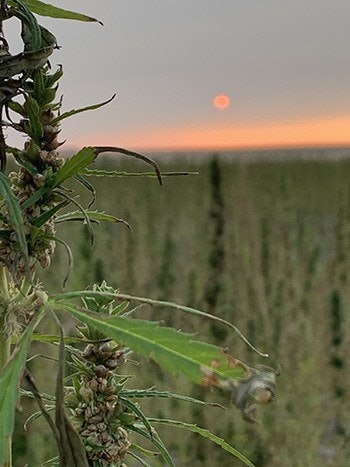 ron rabou farms
ron rabou farmsThis first harvest is part of a broader story for Rabou. He is eager to see Wyoming farmers embrace this new crop. The state issued hemp productions licenses to 25 farmers this year, for a total of 850 acres. Yes: Rabou’s crop accounts for one-fifth of all Wyoming hemp production in 2020.
“I'm really passionate about Wyoming agriculture, and I think that Wyoming largely has done an extremely poor job of diversifying its economy,” he said. “I think that this is one way to bring relevancy back to Wyoming agriculture. We're not Iowa, you know what I mean? You can't grow all kinds of crops here. We farm at 5,300 feet of elevation and we get an annual precip., if we're lucky, which we weren't this year, but we typically receive an annual precip. of about 16 inches. So, it’s not the farming Mecca of the United States, but there is potential here.”
He added that one significant obstacle to diversifying Wyoming agriculture with industrial hemp is the old stereotype associated with hemp’s THC-rich counterpart. “People want to poke fun at the fact that, ‘Oh, well, look at the marijuana farmers,” Rabou said.
It’s a salient point, especially as the new U.S. hemp industry grows by leaps and bounds (and as states around the country continue to legalize medical and adult-use cannabis). It’s a matter of normalization, which takes time.
“Wyoming is certainly a viable state for agriculture, and we have a department of agriculture that's grossly underfunded,” Rabou said. “We really need to change our mindset in this state. I mean, the definition of insanity is doing the same thing over and over and expecting different results. We have been doing that for decades in this state, and, really, it's time that we step out of the box. It's time that we set the stereotypes aside and that we properly educate ourselves to fully understand the value that diversification in the economic sector will bring to our state and, quite frankly, to every state. That’s going to be a joint effort between legislatures, law enforcement, the business community, the farming community—all of us.”











